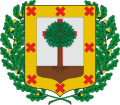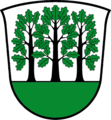Oak (heraldry)
The oak is a popular common figure because of its strong symbolism in heraldry .
It stands for strength, persistence and for struggle, including victory. In the Germanic world of faith it always played a special role as a sacred tree. What is shown by the oak in the coat of arms often suggests the personal characteristics of the bearer of the coat of arms .
All parts of the oak are strongly stylized in the coat of arms . The tree, the leaves and the fruits called acorns are shown.
The tree is always shown with a spreading crown on a strong tree trunk in the coat of arms. Two trees from a trunk are a heraldic peculiarity. This common figure, known as the double oak , became a symbol of the togetherness of the duchies of Schleswig and Holstein in the course of the conflict between Danes and Germans over the status of Schleswig-Holstein under international law in the middle of the 19th century .
Leaves and fruits are often shown individually or in threes in the coat of arms. Branches, trunks, stumps with leaves are used as leafy described . The oak is preferred in the colors green and gold, but also in silver. The oak is also widespread in religious orders. Many orders and decorations are surrounded by an oak wreath or decorated with oak leaves . The oak even gives its name to an order of knights : Order of the Oak . The oak is also suitable for a talking coat of arms . The “acorn on the branch” appears as a mint master's mark in the Saxon mints of Bautzen (1668) and Dresden (1640–1678).
Examples
Coat of arms of Aichach , Bavaria
Coat of arms of Aichhalden , Baden-Wuerttemberg
Tree and wreath around the coat of arms of the province of Bizkaia , Spain
Dreieichenhain (district of Dreieich )
Three trees, Echem , Schleswig-Holstein
Branch with leaves and acorns in the coat of arms of Eichberg SG , Switzerland
Coat of arms of Eichen (Schopfheim) , Baden-Wuerttemberg
Stylized oak, consisting of three leaves and two acorns, in the coat of arms of Eichenau , Bavaria
Leaf and acorns in the coat of arms of Neu-Eichenberg , Hesse
Coat of arms of Dreieich , Hesse
Coat of arms of Eberswalde , Brandenburg
Coat of arms of the city of Hagen , North Rhine-Westphalia
Herdecke near Hagen
former coat of arms of Herne , North Rhine-Westphalia
three young oaks in Hoyerswerda , Saxony
Coat of arms of Langen , Hesse
Double oak in the coat of arms of Looft , Schleswig-Holstein
Offenbach am Main , Hesse
Leaves in the coat of arms of Timmerlah , Lower Saxony
Oak leaf in the full coat of arms of the BDIC




















